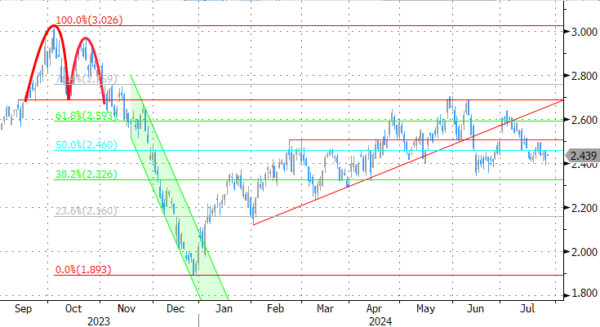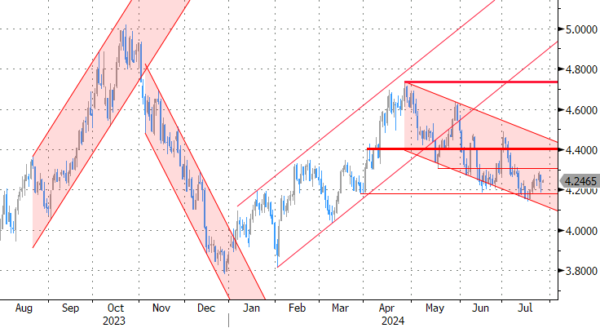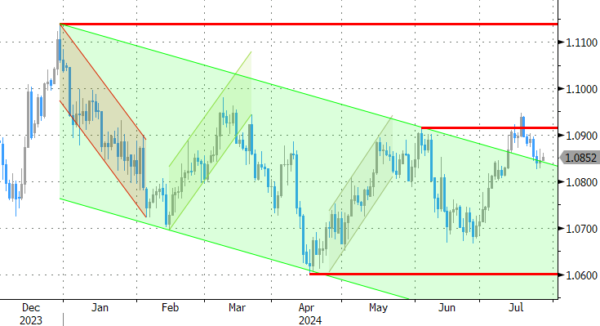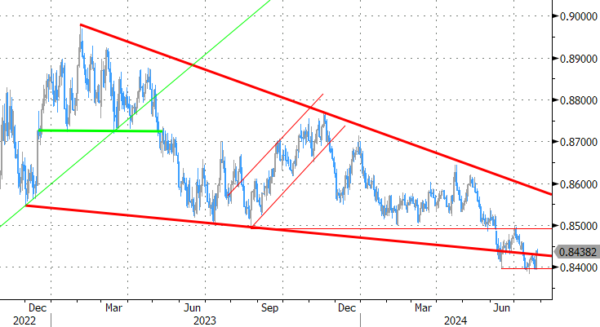Markets
The IT-driven risk-off initially supported a classic safe haven run on core bonds yesterday. German yields at some point lost another 5-7 bps. However, equities gradually found a bottom going in the opening of US markets, looking forward the US data. US Q2 GDP growth printed higher than expected at 2.8% Q/Qa (1.4% in Q1 and 2.0% expected) with still a solid contribution from private consumption (+2.3% Q/Qa). Price indicators were mixed (GDP price index lower than expected at 2.3%, but core PCE deflator higher than expected at 2.9%). Jobless claims declined slightly more than expected (235k) and core durable goods orders also beat expectations. These data at least don’t suggest the Fed should rush into a big (communication) U-turn at next week’s policy meeting. On Wednesday, markets still largely ignored a solid US PMI report, but yesterday’s data finally triggered a tentative bottoming out process on the recent sharp decline in yields, especially at the short end of the curve. The US 2-y yield finished the day little changed at 4.43%. Longer yields also closed off the intraday lows but still declined up to 5.8 bps (30-y). Similar narrative on European yields with German yields at the end of the day declining between 2.1 bps (2-y) and 3.2 bps (30-y). Both the S&P (-0.51%) and the Nasdaq (-0.93%) still closed in negative territory, but selling pressure also tentatively eased intraday. The performance of the dollar again was unconvincing, mixed at best. DXY closed little changed (104.35). USD/JPY intraday tested the 152 area, but closed the session little changed near 154. EUR/USD, despite recent poor data (including the IFO confidence yesterday) even gained marginally (close 1.0846). EUR/GBP even staged a remarkable rebound off the 0.84 support area (close 0.844).
Asian equity markets this morning show signs of stabilization but gains, if any remain limited. US yields are holding near yesterday’s closing levels. The dollar is losing a few ticks again (DXY 104.27, USD/JPY 153.77, EUR/USD 1.0855). Later today, the focus will be on the US July spending and income data and on the related price deflators. Headline PCE inflation is expected to cool to 0.1% M/M and 2.4 Y/Y, the core measure is seen at 0.2% M/M and 2.5% Y/Y (from 2.6%). We don’t expect this report to bring big additional news going into next week Fed meeting. If the equity sell-off halts (at least temporarily), core yields also might look for a bottom after recent sharp repositioning. We look out whether the US 2-y yield will manage to close above the 4.40% reference. For the EMU 2-y swap the 3.0% barrier is an interesting reference. Recently the dollar performance against the other majors (euro, yen) was unconvincing and we don’t see that changing short-term.
News & Views
Inflation in Japan’s capital city Tokyo using the Bank of Japan’s preferred gauge (ex. fresh food) accelerated from 2.1% y/y to 2.2% in July. The uptick was supported by monthly increases in utilities (+2.8%), transport & communication (+0.5%) and entertainment (+1.3%). Fresh food tumbled 2.7% m/m, helping to explain the drop in overall Tokyo CPI from 2.3% to 2.2%. The core gauge excluding fresh food and energy prices slipped from 1.8% to 1.5%. In addition with services price inflation slowing to just 0.5% (unchanged on a monthly basis) from 0.9% the month before, today’s numbers once again provide no clear signal for the Bank of Japan when it meets next week. The weak yen has been a headache for policymakers in the country and argued for rate action but the currency over the past couple of days dramatically appreciated against the likes of USD and EUR. This is likely to relief the BoJ of some pressure too. USD/JPY’s sharp decline did shift in lower gear following yesterday’s stronger-than-expected US Q2 GDP data though. The pair is currently trading slightly lower around 153.58. This compared to the 161+ levels at the beginning of the month.
Hungarian minister for economy Nagy said the recovery this year and the next will be weaker than hoped for, raising the possibility of additional stimulus in the 2025 pre-election year. The 2024 rebound is seen at 2.2-2.3% instead of the 2.5% estimate in April. Economic growth next year could then “approach” rather than “exceed” 4% provided that export markets recover and the government uses the 2025 budget to boost the economy, Nagy said, hinting at help for small businesses and families. The cabinet will submit its 2025 budget draft in November. Nagy’s comments feel weirdly timed, coming at a time when Hungary is trying to keep its deficits under control. The administration recently announced a fiscal stabilization plan to keep the 2024 deficit under the 4.5% of GDP target.
Graphs
GE 10y yield
The ECB cut its key policy rates by 25 bps at the June policy meeting. A more bumpy inflation path in H2 2024, the EMU economy gradually regaining traction and the Fed’s higher for longer US strategy make follow-up moves difficult. Markets are coming to terms with that. Meanwhile, much of the save haven bids were reversed after the (first round in) the French elections. The 2.34%-2.4% support zone looks solid.
US 10y yield
The Fed indicated that it needs more evidence to lower its policy rate. June dots suggested one move in 2024 and four next year. Disappointing ISM and back-to-back downward CPI surprises put the US money market back on (at least) two rate cuts this year (September/December). The US 10-yr yield tests the recent lows and the downside of the downward trend channel in the 4.2% area.
EUR/USD
EUR/USD tested the topside of the 1.06-1.09 range as the dollar lost interest rate support at stealth pace. Markets consider a September rate cut a done deal and only need confirmation from high-ranked Fed officials. In the meantime, the euro got rid of the (French) political risk premium. EUR/USD recently evolved back to a more neutral positioning but is holding up rather well despite ongoing poor EMU data.
EUR/GBP
Debate at the BOE is focused at the timing of rate cuts. May headline inflation returned to 2%, but core measures weren’t in line with inflation sustainably returning to target any time soon. Still some BoE members at the June meeting appeared moving closer to a rate cut. Labour has yet to reveal its policy plans after securing a landslide election victory. EUR/GBP 0.84 support is being tested.















